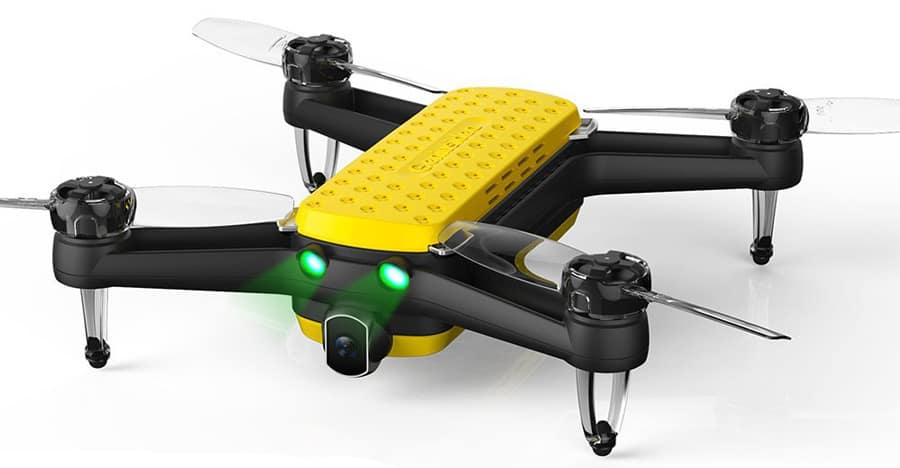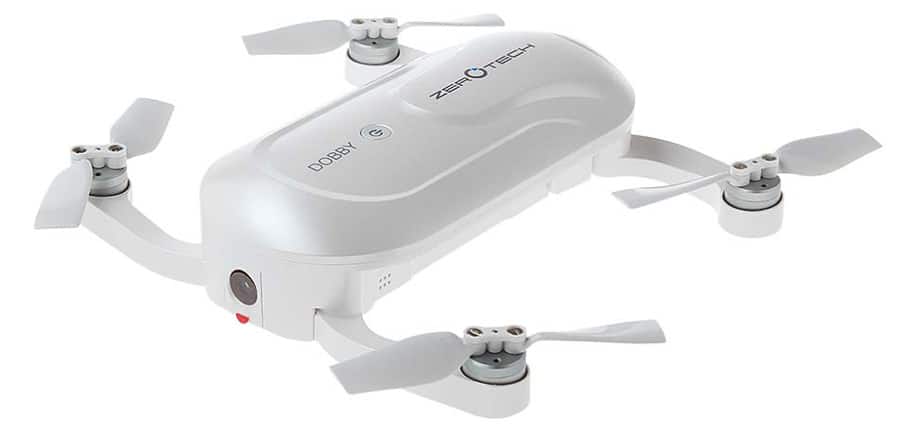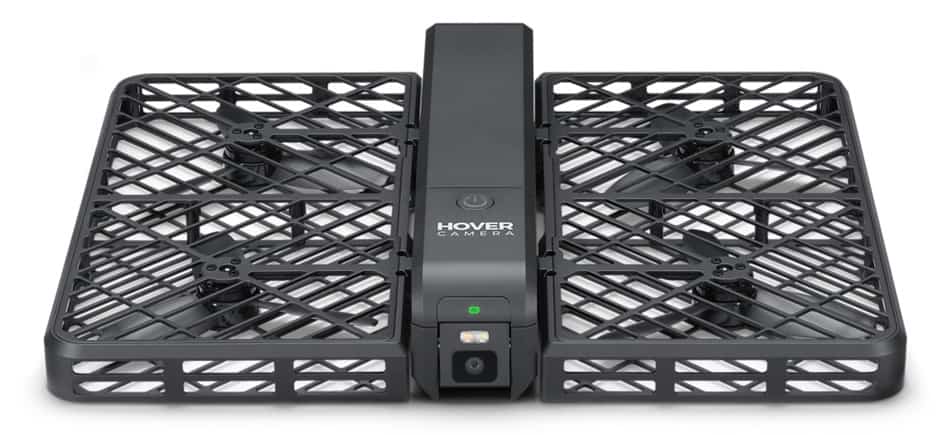Wouldn’t you guys love a drone that could recognize your face and do all sorts of things when focused on it? Imagine setting it to focus on your beautiful smile and then command it to orbit around you or follow you around everywhere you go. It’s would be a neat little trick, wouldn’t it?
Don’t worry guys, we aren’t building up your imaginations for anything. In fact, there are several widely available drones with sophisticated facial recognition software onboard. It’s not science fiction – it’s reality! And guess what, they don’t cost a fortune either… Better yet, I took the time and came up with a list of 4 best face recognition drones. Let’s check them out!
Table : Drones with Facial recognition
| Name | Image | Camera | Range | Time | Best Price |
|---|---|---|---|---|---|
| 4. GeniusIdea Follow | 4K | 100m | 20 min | See best offer | |
| 3. Zerotech Dobby | 4K | 100m | 9 min | See best offer | |
| 2. Hover Camera | 4K | 20m | 10 min | See best offer | |
| 1. DJI Spark | 1080p | 2000m | 15 min | See best offer |
Best Face Recognition Drones :
4. GeniusIdea Follow
Starting off with Follow by Genius Idea, we are looking at an interesting concept that might as well prove to be foolproof. You see, the biggest strength of this mini-drone is its unconventional design. In addition to that, it also sports some fine hardware inside. Let’s not forget about its fine array of features that set it aside from certain competitors. But, is all that enough to make it a great choice for a face recognition drone? Let’s see…
Camera and Features
As stated above, the design of GeniusIdea Follow is an outright strong point. It is made entirely out of highly durable rubber-like materials. As a matter of fact, even the blades are made out of the same material which responds greatly to bends, twists, and turns. It’s amazing! You will save a lot of time and money by not having to replace damaged props all the time. Furthermore, since the centerpiece is made out of the same material GeniusIdea Follow is basically indestructible and can take quite a lot of beating.
Camera-wise, GI Follow sports a 4K ready sensor with electronic image stabilization (EIS from now on). However, you can use it when recording in FHD or below – EIS will not work in 4K. Despite that, the overall image quality is astonishing and facial recognition software kicks things up a notch by allowing smart flight features such as Follow Me… hence the name GI Follow.
Specifications
As far as performance is concerned, GI Follow looks like a solid model… with one twist in its tale. You see, this little fella doesn’t work on conventional LiPo batteries like all other models currently available on the market. Instead, GI Follow opts for 18650 batteries. These can be found for dirt cheap. However, if you are interested in having more flight time (check out more drones with long flight times), I suggest going for a slightly more expensive pack that can yield up to 20 minutes of flying. As far as the range is concerned, you will have approximately 100 meters at your disposal. it might not seem like a lot at first, but it’s somewhat of a standard number for these mini facial recognition drones.
3. Zerotech Dobby
Third place goes zo Zerotech Dobby. This drone has received a lot of hype back in the days when it was initially released. Upon the release, it was one of the first miniature autonomous drones with a proper camera. With a foldable design, small form factor and great overall performance, Dobby quickly captivated the hearts of many. However, with lots of new models on the rise these days, can it still live up to its old fame? Hmm, there’s only one way of checking that out and that’s by taking a closer look at it and seeing what’s it all about!
Camera and Features
First of all, it’s important to note that this little birdie sports a tiny 13MPX sensor. It carries integrated EIS which works with recordings at or below 1080p. With that said, this 13MPX sensor can record aerial videos in 4K too, but you won’t have access to that extra layer of smoothness.
Moving forward to the features, in addition to face recognition, Dobby has a bunch of others that might be interesting to some of you. They include voice control, tap to fly, flight path options and GPS + GLONASS coverage. Lastly, all these features are running on a powerful Snapdragon SOC with 2 gigs of RAM and 2.3GHz Quad Core processor. Plenty of power for such a tiny little fella, don’t you agree?
Specifications
As far as numbers are concerned, Zerotech Dobby is not capable of delivering anything above the ordinary. If you are interested in its flight time, you should expect somewhere around the 10-minute mark. Perhaps a minute or two less than that if you plan on recording a lot. Finally, operating range goes somewhere around 100 meters away from the controller (yes, Zerotech Dobby is a smartphone-controlled drone) which is, once again, a standard for this tiny beasts.
2. Hover Camera Passport
One step from the top spot we have a very special drone in store for you. It has gained a massive amount of popularity as soon as it got released. Many popular YouTubers (including Unbox Therapy) did reviews for it since it features an astonishing price/performance ration. Something that we rarely see nowadays. But still, DJI Spark which is placed in the top spot delivers slightly better overall performance. So, with that said, let’s take a closer look at Hover Camera Passport and see what’s it all about!
Camera and Features
The camera is obviously the strong point of this model since it has the word Camera embedded into its name. But how good is it? Well, let’s start off by stating that its a tiltable 13MPX CMOS sensor with a 78.4-degrees field of view. Furthermore, it is capable of recording in 4K resolution and capture brilliant selfies no matter the occasion. The image quality is unparalleled and delivers on all fronts. No drawbacks in this department.
Features-wise, Hover Camera Passport provides a pleasant experience. Not flying-wise though as this model is focusing fully on autonomous flights. Plus, it is insanely stable in the air thanks to a brilliant implementation of Altitude Hold. This makes up for smooth aerial videos and picture-perfect selfies. Additionally, you’ will also love
Specifications
Weighing in at just 242 grams and having a spectacular foldable design, Hover Camera Passport definitely falls into the category of miniature drones. Even with its safety-first oriented design which brings in a few extra grams… but that doesn’t stop this little birdie for performing. As far as flight time goes, 10 minutes is roughly the amount of time this birdie can produce per charge. On the other hand, operating range isn’t exactly the brightest point with approximately 20 meters of space. Don’t be alarmed though, Hover Camera Passport can still take brilliant selfies within this distance, there is no doubt about that.
1. DJI Spark
At the moment, the best drone with face recognition is definitely DJI Spark. This feature is a part of Spark’s identity and functions with the entire system in a way never seen before. Simply tap DJI Spark when it is pointing towards you and when it turns on, facial recognition will boot up as well and immediately scan your face. After that Spark will rise up and the fun can begin…
Camera and Features
Out of this entire bunch, DJI Spark is the only drone whose FHD-ready camera runs on a hardware stabilization system. Yup, it is true – this little fella sports a fully fledged gimbal. Not a 3-axis one though – DJI Spark’s gimbal is just 2-axis, but it’s still more than enough to give you full control over the scenery. An extra dose of smoothness and anti-vibration in your aerial videos will give you a world of good too, but that’s to expect from a premium facial recognition drone such as this one.
Also, it is safe to say DJI Spark promotes the biggest feature list out of all drones showcased here. There is fluent GPS coverage as well as a huge array of autonomous flight options that will make aerial photography a simple task. Gesture controls are here too, as well as PalmLaunch and PalmControl which make a solid handsfree controlling mechanism. All in all, if you are looking for a feature-packed drone with facial recognition, look no further because DJI Spark can provide!
Specifications
Last but not least (not by a long shot, if we are being honest here) – DJI Spark specifications are on the table. Starting off with operating range, DJI Spark doesn’t feature OcuSync which means its standard range isn’t anything special. Barely above average in contrast to all 3 drones above. However, DJI Spark Fly More Combo fixes that thanks to the provided controller which boosts the range up to 2 kilometers. Now that’s quite the distance for this little birdie, right?! Airtime goes a lot above the average 10 minutes. More precisely, DJI Spark can endure approximately 15 minutes in the air without breaking a sweat.
What is face recognition?
Now that we counted down to the best facial recognition drone currently available on the market, I guess it would be a good time to tell you a bit more about the feature itself. So, without much further adue, let’s see what’s it all about!
In most cases, facial recognition systems use data gathered from the camera and analyze it through comprehensive algorithms to decide whether or not there’s a face in the frame. So technically, they don’t work on the same principle as, for example, Apple’s new tech. Apple’s facial recognition efforts are focused on security while drones are only interested in improving their autonomous flight ability.
In other words, facial recognition cannot differentiate your face from, let’s say, your brother’s, friend’s, neighbor’s and thus decide whether or not it should fly. It can only recognize whether or not there’s a face in its frame. If it is, this will result in unlocking of drone’s autonomous flight abilities and (in some cases) turn on hand gestures and/or voice commands.
Drones with Face Recognition : FAQs


Facial Recognition systems, in most cases, rely on data captured directly from the camera. They do this in a real-time manner and use comprehensive algorithms to maintain a focus on a face in the frame. It sounds pretty straightforward at first glance, but if we dig deeper into the topic you’d realize it’s a clusterfuck of coding.
But how does it help drones? Well, take DJI Spark as the perfect example. Thanks to facial recognition software it enables its users to takeoff and take full control over their drone without much tampering around the menus. They are automatically recognized by the FR software which not only drives that but a ton of other smart flight features as well.
In contrast to this, you’d be surprised at how many people think these miniature drones are highly overpriced and cannot deliver a proper performance. I’m happy to inform them that they’re terribly wrong. These birdies might not be as fast as full-sized models, but they possess superior stability and ease of use which makes them great entry-level photography platforms. Even more so thanks to the built-in facial recognition software that lets you do magical things.

But does that make it the best one? Well, I’d put it right up against Hover Camera Passport. It doesn’t have such outstanding stabilization onboard but can record 4K. Image stability is not an issue despite the lack of hardware stabilization so I guess it can take this crown.
Conclusion
It’s all fun and games until someone mounts a sophisticated face recognition system into a drone… After that, they become fully autonomous flying devices and used for all sorts of things. Just think about this for a second – US Border Patrol has open bids for face-recognizing drone fleets. Needless to say, the technology is advancing rapidly.
Of course, face recognition drones viable for surveillance use are nowhere near these 4 featured above. I mean, their prices start at $200 which, let’s face it, can’t grant you eagle vision. But nevertheless, if you’re looking for a miniature drone that uses its face recognition software for autonomous flight, all 4 above can provide. DJI Spark is still the best one out of the bunch, but the priciest as well. If your budget says yes, then I say GO FOR IT!
Thank you for reading guys…
Until next time – Happy flying!
DronesGlobe
The post These 4 Drones Can Recognize Your Face. What are benefits of having that functionality ? appeared first on DronesGlobe.com.






No comments:
Post a Comment